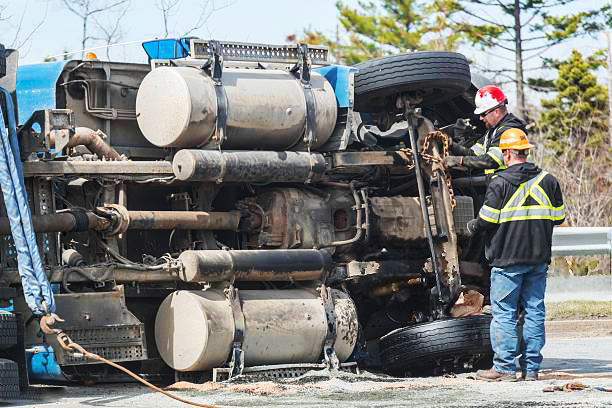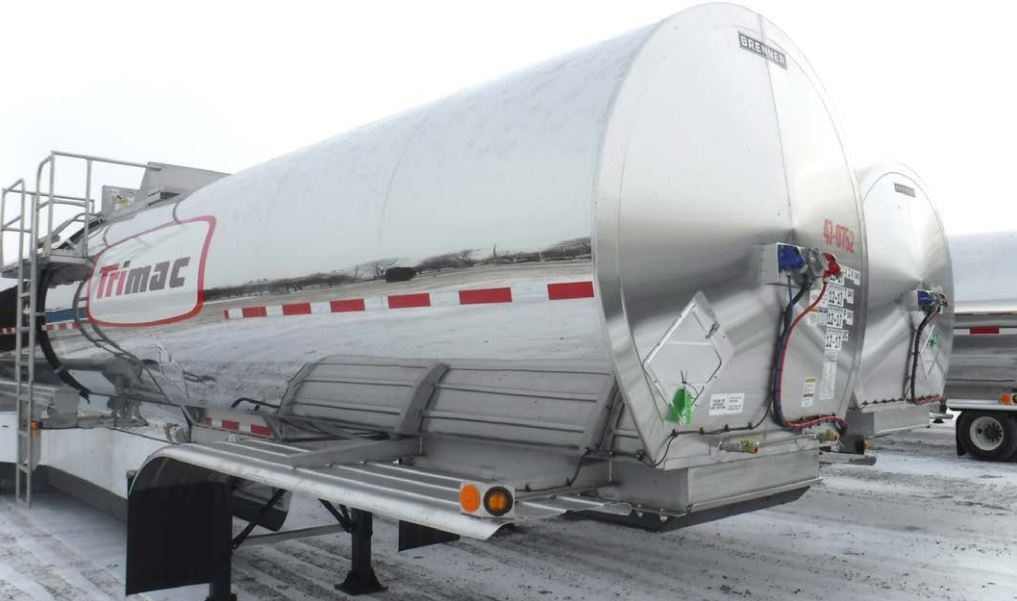Every second counts if a spill begins, and every type of spill presents unique challenges.
”Our drivers are not only drivers. They’re professional product handlers.
Marcel PouliotVice President of Safety and Fleet innovation, Trimac Transportation
The trucking industry has an envious safety record when it comes to hauling the 2,200 products classified as dangerous goods. According to the Ontario Trucking Association, there’s about one spill for every 40,000 shipments, and that’s even when the smallest releases are included in the counts.
But when a liquid or gas does begin to escape from a tanker, barrel, or other supposedly contained space, a bad day can quickly become worse. Setting aside the cost of the lost cargo, the threats that begin to emerge can range from fires, to explosions, environmental disasters, and long-term health effects.
No matter what the commodity might be, time is of the essence – and the first people on the scene of a spill will inevitably be those who work at the wheel.
“Our drivers are not only drivers. They’re professional product handlers,” says Marcel Pouliot, vice president of safety and fleet innovation at Trimac Transportation, referring to the roles they play.
A focused spill response plan and regular training will help to ensure they have the skills for the job, and the right tools at their disposal.
“We have an emergency response plan that every driver has a copy of,” says Sheldon Jonasson, Jade Transport’s driver services, safety, and training manager. And drivers aren’t the only people to be prepared. “We also have an emergency response plan for dispatch, and we have a guy in the fire department I have worked with who has years of experience working with rollovers,” he says.
“I think [the plan] has to be developed customer by customer, depending on the type of product they’re hauling. Everybody is different,” adds Gino Mella, co-owner of G&D Tank and Trailer in Milton, Ont.
The first step as a leak begins is obviously caring for people, even if that involves telling everyone that a product has been released and they need to evacuate. “Everyone wants to film everything,” Pouliot says, referring to those who seem more focused on posting content to social media rather than watching for personal dangers. Then it’s a matter of calling 911, and administering first aid. “Every single Trimac employee or contractor has a valid CPR certificate,” Pouliot adds. Fleet offices and insurers need to be called to commit resources as well.
Requirements of who to call can even vary by lane since some provinces and states have unique environmental-related rules, he adds. Ontario, for example, has a Spills Action Centre, but some individual municipalities expect public works departments to be notified, depending on where a spill takes place.
”There’s no training body that trains people – drivers or technicians – on tanker trailers. There has to be someone to organize that,
Gino MellaCo-owner of G&D Tank and Trailer
SPILL KITS
When it comes to addressing the spill itself, spill kits will offer the first line of defence. But even those tend to be designed for specific commodities, which creates a planning challenge for fleets that leave docks with one type of product and return with something different.
“We can standardize something, but if someone is hauling food product and another person is hauling a hazmat acid, there are different spill response plans and spill kits required. One may not help the other,” Mella explains. “If you try to unify them, you have overkill for one and for another it’s the right one. I think they have to be designed on a custom-built application for each customer depending on what they’re hauling.”
But every kit starts somewhere. A general spill kit might include an absorbent material and spill-trapping tools like socks, booms, and sewer covers. “We’ve had those in our trucks going back to the 1990s,” Pouliot says, noting how the fleet worked with a supplier to include the related instructions on the pouch. “There are multi-purpose ones, but we found there was a lot of stuff in them we didn’t need,” Jonasson insists. “All our drivers are equipped to handle whatever they’re hauling, with rubber gloves and chemical suits. So we did away with the cheap rubber gloves and stuff we didn’t need.”
The kit that emerged can handle issues ranging from a leaking hose to any spill of between 25 and 30 liters. There are 30 chemical spill pads, a 12-foot boom, two-pound jar of dry neutralizer for acids, and a 4×4 rubber mat to cover drains. Yellow garbage bags help to ensure that nobody mistakes the collected material for traditional waste.
Spill kits are not limited to materials that plug and cover, of course. Special explosion-proof flashlights will help to ensure that nobody is put at risk when looking to put the things in place, Pouliot says as an example. Diesel-operated pumps, meanwhile, won’t generate the sparks that can cause trouble.
TRAINED TEAMS
There’s certainly a demand for the expertise of trained spill response teams. Trimac, for example, has emergency response teams based in Ontario and B.C. And most of them have received specialized training at a facility in Pueblo, Colorado. “You’re out in the middle of nowhere. You’ve got a diesel spill,” Pouliot says of that training. “Then they’ll set off a stick of dynamite.”
Knowing how to control the leak is only part of the equation, though. Any environmental damage needs to be addressed. Using licensed and specialized suppliers will ensure responses answer legislated demands.
Times certainly have changed. “Before, if you had a spill of gasoline or diesel fuel, you would dig it out,” Pouliot says. Now environmental
companies can identify ways to reclaim an area by adding bacteria in the soil to eat up a specific pollutant. “Environmental companies have a much greater scope of approved reclamation options to them today.”
The company chosen to accept the reclaimed material will make a difference of its own. “If there is a spill and there’s some contaminated soil, where does it go? Does it go to ‘John’s Dump’ that has a government licence, or one of the multinationals that does this for a living?” Pouliot asks. If a dump site in the U.S. is later proved to be a source of contamination, and a Super Fund site is declared, regulators reach out to everyone who ever used it. Then the clean-up costs will continue to mount.
Even shop teams have a role to play in preventing the dangers of spills that might occur. It’s why Mella insists that tanks are not worked on until they are certified as clean. “Even running gear work,” he insists. “Whether it’s food-grade [tanker] or not, it has to be clean.”
Mella would also like to see a broader focus for related spill training that does exist. “There’s no training body that trains people – drivers or technicians – on tanker trailers. There has to be someone to organize that,” he says. “It has to be people who are knowledgeable about tank trailers – the hauling, the servicing – who can relay all the messages.” But the available resources have come a long way.
“I sleep a lot better today because the emergency response service community is so much better-prepared today than it used to be,” Pouliot says. “The level of expertise has gone up in fire departments and public works.”
“People make a career out of it now,” he says.
SPILL KITS AND TIPS

The clock is ticking from the moment a spill begins. It’s why drivers need to be well-trained in the procedures that will keep a bad situation from becoming worse. Consider these spill-controlling tips from David Goruk, Northbridge Insurance’s manager of risk services, transportation and logistics, in the Ontario and Atlantic regions:
KNOW YOUR CARGO
Specific commodities present unique needs, driving the choice of tools such as personal protective equipment (PPE) and materials found within a spill kit. Some spills also present a bigger immediate threat than others. A barrel of resin or ink, for example, may not present the threat of an immediate explosion. “If it’s volatile,” Goruk says, “we need to get away.”
WATCH THE WATERWAYS
A bad spill will quickly become a catastrophe if unwanted material contaminates a local waterway. That’s why it’s so important to surround and cover any catch basins in a spill’s path. “Even if [drivers] have nothing, usually a truck has floor mats you can cover a catch basin with,” Goruk says. The blankets or mattress in a sleeper could soak up material as well.
CALL IN THE EXPERTS
Personnel capable of attacking a spill can be identified by fleets and insurers alike. “The insurance carrier would more than likely dispatch one of their vendors to the scene,” Goruk says as an example. One of the most important numbers, outside 911, can be 1-888-CAN-UTEC (226-8832), or *666 on a cellular phone. That will likely be used by a typical LTL carrier which lacks a specialized spill response team.
GUIDE WITH GUIDES
Transportation of Dangerous Goods (TDG) training will teach how to use a spill response guide. Drivers should have related TDG paperwork readily accessible, and be carrying a TDG spill response guide and know how to use it.
WATCH FOR EMERGING LEAKS
This seems like basic advice, but leaks can be caused by more than major collisions alone. Road debris has been known to kick up from a road and cause a fuel leak. “Anything can happen,” Goruk says.
TAKE PROACTIVE MEASURES
If loading pails near the nose of a trailer, LTL carriers would be wise to post a warning on the pallets ahead of it, Goruk says. Otherwise, a forklift operator can push right through the bottom of a skid and into the barrels behind it.
DON’T FORGET THE DOCK
Spills don’t all happen on the road. Dock areas should be equipped with the same booms, drain covers, and absorbent mats used in the trucks, as well as specially designed spill containment drums that can hold a smaller leaking container.


Recent Comments